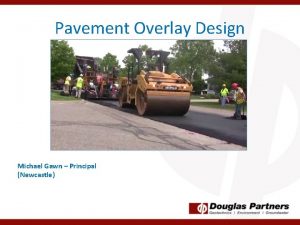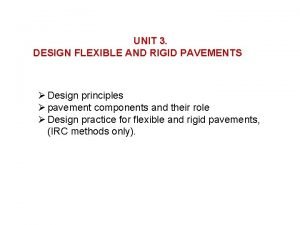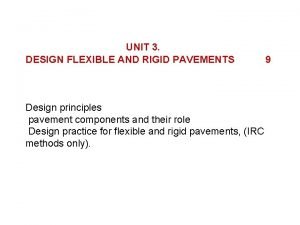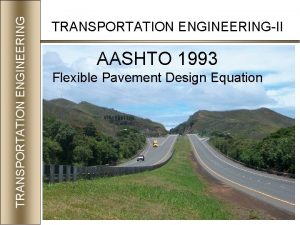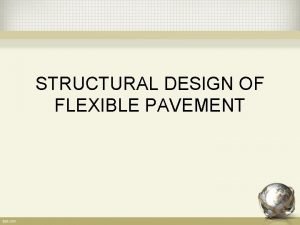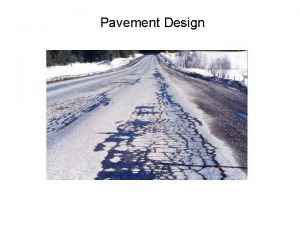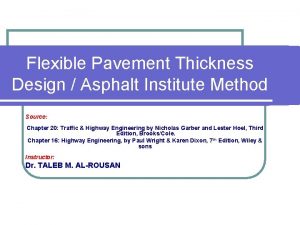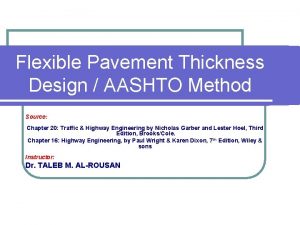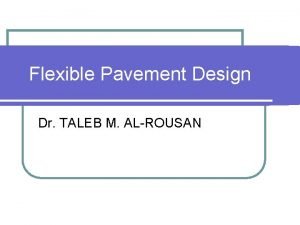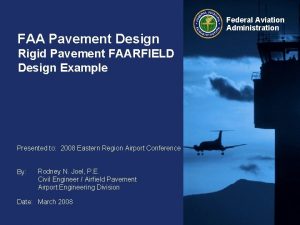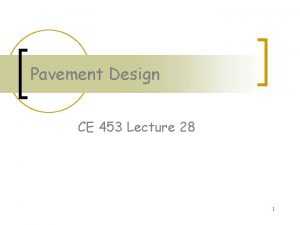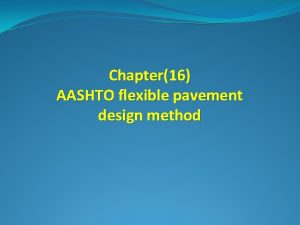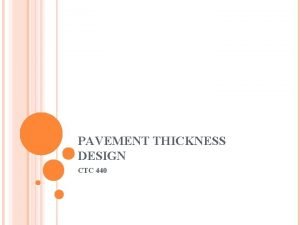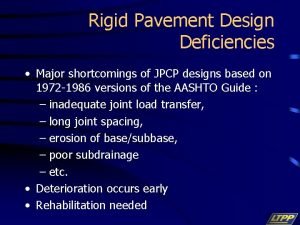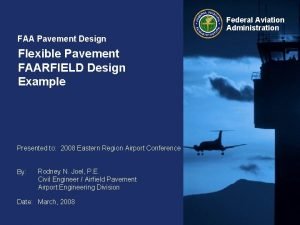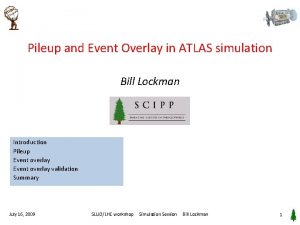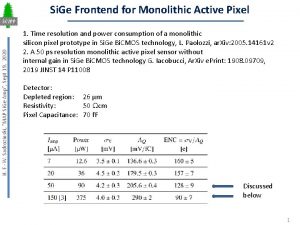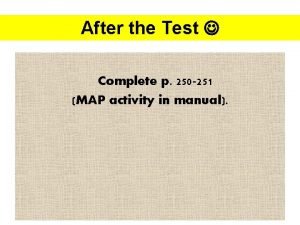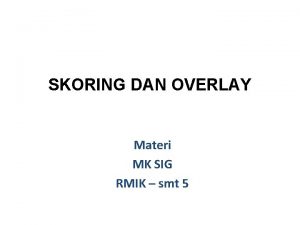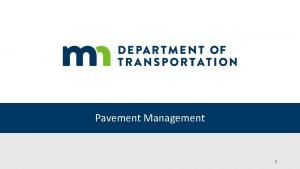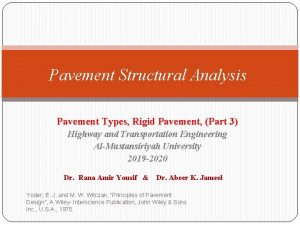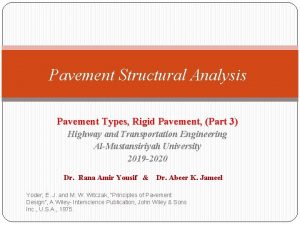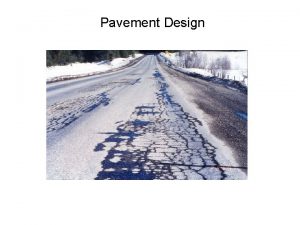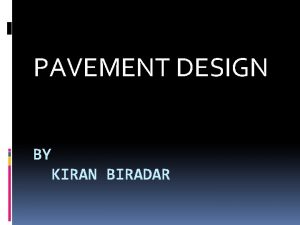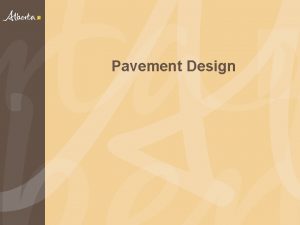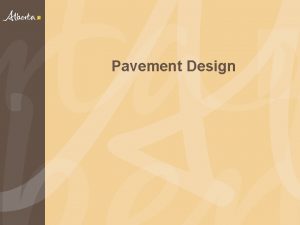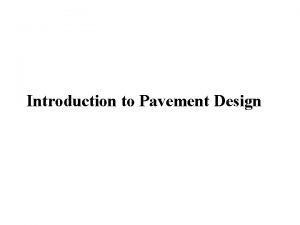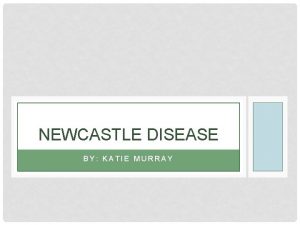Pavement Overlay Design Michael Gawn Principal Newcastle Why





























- Slides: 29

Pavement Overlay Design Michael Gawn – Principal (Newcastle)

Why Overlay? • Cheaper than reconstruction • Suitable for shorter life span (asset prioritisation) • Faster than reconstruction/stabilisation

Types Of Overlay Several types: Granular Ranging from 50 mm to 200 mm or so, pavement material (can be stabilised) Asphalt Ranging from 40 mm to 100 mm or so, asphalt (can be several layers). Can be thin or deep lift Concrete Mainly over existing rigid pavements (stitched in)

Types Of Overlay Limits: Granular overlays up to 108 ESA Asphalt overlays up to 107 ESA

Basis for Overlay Design • Based on pavement deflections (and curvature) • Need to ensure sufficient existing structural thickness • Improving road structure to allow it to satisfy increased traffic load (i. e. life) • Remember drainage is an important consideration

Data Collection Deflection testing of road • Benkelman beam • Falling weight deflectometer (40 k. N) • Deflectometer

Data Collection Curvature = D 200 – D 0 • Beaming • • Take readings regularly (say 10 m to 20 m in both wheel paths) Alternating wheel paths is usually undertaken Record rebound deflections at: • 200 mm • 600 mm • 900 mm • 2700 mm • 9000 mm Very important to take pavement temperature

Data Collection • Pavement Condition • Inspect pavement for defects: • • • Rutting (can be indicator of subgrade failure) Shoving (subgrade failure or poor gravel) Cracking (cemented material? ) Edge break (thinning on edge? ) Austroads Guide to Visual Assessment of Pavement Condition • Draw maps • Extent of damage • Type of damage • Drainage conditions!!! • In-ground service trenches

Overlay Design - Types • Heavy Patching • • • In-situ Stabilisation (incorporating existing) • • Improve conditions where existing gravels have high plasticity Allows thinner increase in pavement thickness Re-uses some existing material Granular Overlay • • • Can be used to correct short sections where full reconstruction is not economical Where finish level constrained (i. e. kerb and gutter) Can be cheaper than AC Use where levels not constrained Asphalt Overlay • • Thinner than granular Greater structural improvement

Overlay Design Procedure • Segment Pavement into areas of similar One outlier result – service trench? deflection performance • • • Based on coefficient of variation (CV) Design Deflection – what deflection needs to CV = Standard Deviation / Mean (of deflection be to cope with projected traffic results) Segments should ideally by greater than 100 m Remove result (heavy patch) and remaining road meets deflection criteria

Overlay Design Procedure • Characteristic Deflection • Indicator of overall performance of pavement segment: • • µ = mean of deflection readings f = factor for road function (how busy the road is) Where <30 readings, max deflection can be better

Overlay Design Procedure • Characteristic Curvature • Mean of curvature results in segment Curvature = D 200 – D 0

Overlay Design Procedure • Determine design deflection from design traffic Example: For 106 ESA design deflection is 1. 18 mm

Overlay Design Procedure • Adjust deflection data for • • • Method of collection Seasonal variation Pavement temperature

Deflection Standardisation Factor - Method

Deflection Standardisation Factor - Method

Deflection Standardisation Factor - Temperature WMAPT = mean weighted average pavement temperature – See Austroads Tmeas = temperature at time of testing As AC gets thinner correction gets smaller NOTE: Different graphs for Benkelman beam v FWD No correction needed for <25 mm AC Also correction curve for curvature

Deflection Standardisation Factor - Season • Correction for time / season of testing • Applied to deflection and curvature • Note for silt subgrades could be much greater

Design Procedure – Example • We have determined parameters • Characteristic deflection = 1. 2 mm • Done in November with Benkelman Beam • AC thickness 40 mm • Pavement Temperature = 36 degrees • Going to mill off 25 mm of AC • Adjust for temperature WMAPT/Tmeas = 1. 3

Design Procedure – Example • • 1. 05 Adjust for temperature WMAPT/Tmeas = 1. 3 and therefore adjustment factor of 1. 05 Seasonal factor (temperate climate in Nov) therefore 1. 0 Asphalt thickness

Design Procedure – Example • Seasonal factor (temperate climate in Nov) therefore 1. 0 Most cases

Design Procedure – Example • We have determined parameters • Characteristic deflection = 1. 2 mm • Done in November with Benkelman Beam • AC thickness 40 mm • Pavement Temperature = 35 degrees • Possibly going to mill off 25 mm of AC • Kerb and Guttering • • • Corrected CD = 1. 58 mm Corrected CC = 0. 33 mm For milling depths of up to 50 mm, increase CD and CC by 15% to 25% for each 25 mm of asphalt milled

Design Procedure – Asphalt Overlay • Determine thickness required to avoid asphalt fatigue Two thicknesses can work – very thin <40 mm or above curved line Example: For 105 ESA design deflection is 1. 6 mm Either AC >88 mm (say 90 mm) or less than 50 mm (say 40 mm)

Design Procedure – Asphalt Overlay • Can adjust traffic – and hence overlay thickness for nonstandard asphalts (provided resultant overlay is less than 50 mm)

Design Procedure – Asphalt Overlay • Asphalt overlay – thickness required from characteristic deflection Based on WMAPT of 25° and C 320 binder

Design Procedure – Asphalt Overlay • Where WMAPT > 25° or lower stiffness binder used adjust overlay

Design Procedure – Granular • Use following chart for granular overlay thickness required Need 140 mm

Overlay Design Example • For our example: • Asphalt overlay • 40 mm ok for curvature and deflection (or 90 mm AC) • If mill 20 mm existing: need 65 mm for deflection (but this would be an issue for asphalt fatigue and would need 95 mm AC for curvature) • Granular Overlay • Need 140 mm (but existing kerb and gutter)

Pavement Overlay Design THANKS
 Michael gawn
Michael gawn Flexible pavement vs rigid pavement
Flexible pavement vs rigid pavement Design chart for flexible pavement
Design chart for flexible pavement Rigid pavement and flexible pavement difference
Rigid pavement and flexible pavement difference Prof christian hicks
Prof christian hicks Andreas carlsson bye bye bye
Andreas carlsson bye bye bye Flexible pavement design equation
Flexible pavement design equation Asphalt pavement design example
Asphalt pavement design example Cbr method of pavement design
Cbr method of pavement design Esal example
Esal example Flexible pavement design example
Flexible pavement design example Standard axle load for pavement design
Standard axle load for pavement design Faa pavement design
Faa pavement design Road layer jkr
Road layer jkr Austroads pavement design
Austroads pavement design Objectives of pavement design
Objectives of pavement design Aashto flexible pavement design example
Aashto flexible pavement design example Objectives of pavement design
Objectives of pavement design Jpcp pavement design
Jpcp pavement design Faa pavement design software
Faa pavement design software Don't ask why why why
Don't ask why why why Enemy mechanized infantry section symbol
Enemy mechanized infantry section symbol Overlay transport virtualization ppt
Overlay transport virtualization ppt Triggered overlay
Triggered overlay Hfw map overlay
Hfw map overlay Pc weld overlay
Pc weld overlay Overlay networks in distributed systems
Overlay networks in distributed systems Berlin wall map overlay
Berlin wall map overlay Syarat overlay peta
Syarat overlay peta Overlay-netzwerk
Overlay-netzwerk
